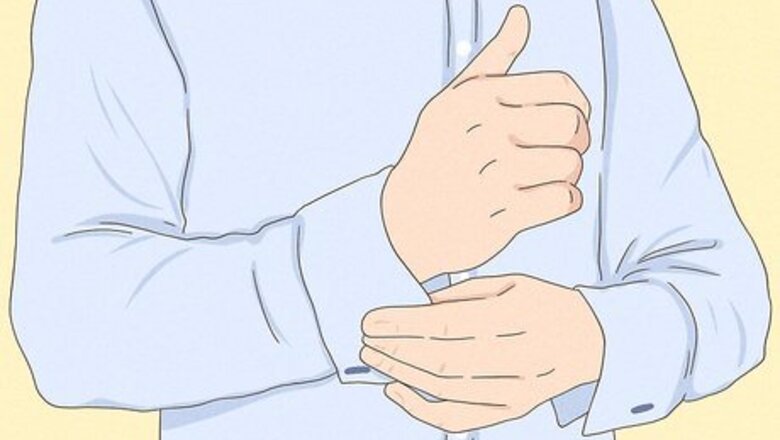
views
- To make a classic roll on a cuffed shirt, fold the cuff at the seam, then fold it over a second time. This works great for formal or professional looks.
- Continue rolling your cuff up to the elbow for a semi-formal basic roll, or past the elbow for a more casual look.
- For a classy alternative, fold your cuff up just past your elbow, then fold your inside-out sleeve up so that just a sliver of the cuff is peeking out.
Classic Roll (Formal)
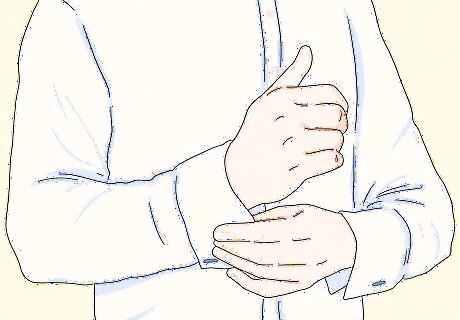
Undo the button on the cuff of your shirt. If your shirt has an additional gauntlet button (the smaller button on the split of the sleeve near the cuff), keep it engaged. Since this is a short roll, the gauntlet button will help keep the look sleek and clean. If you have larger forearms and rolled cuffs feel restrictive, consider undoing the gauntlet button for more freedom.
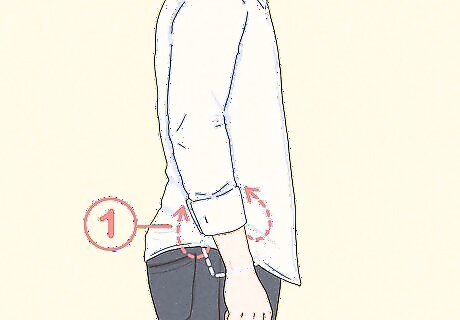
Fold the cuff at the seam between the cuff and the sleeve. Run your fingers through the fold along the seam so that the fold is clean and uniform all around the cuff. The width of the cuff determines the width of your next roll. If you have a stiff dress shirt cuff, resist the urge to fold it in half to make a thinner roll (it will crease the cuff permanently and the roll will turn out bulkier). Fold softer cuffs in half if you really want a thin roll, but remember that folding along the cuff seam looks cleaner.
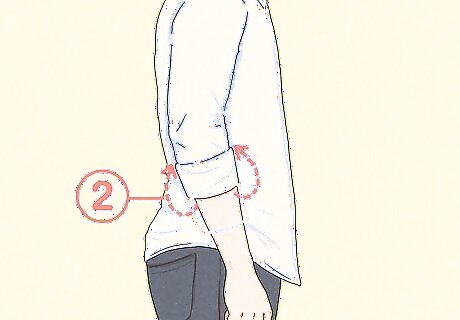
Fold the cuff over one more time to complete the roll. Run your fingers through the fold to make sure the cuff is settled flat for a thin, effortless-looking roll. Adjust the corners so they’re crisp and tidy to maintain a professional, formal vibe. Since only about a third of your arm is showing, you’ll still have that classy, button-up look. Feel free to push the cuff up closer to your elbow to temporarily get it out of the way or look a bit more casual without making additional folds.
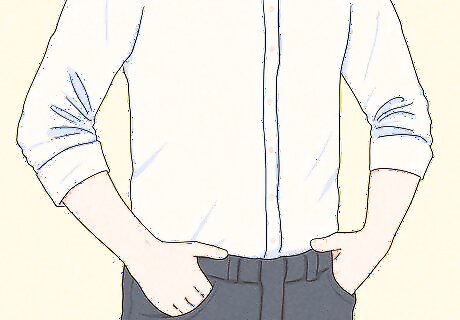
Repeat on your other sleeve. Make sure both rolls look equally crisp and clean to show that you made an intentional stylistic choice. Since you used the cuff to measure your rolls, you won’t have to worry about them being the same length. If you’re wearing a tie, keep it on and fastened with this sleeve roll.
Basic Roll (Semi-Formal or Casual)
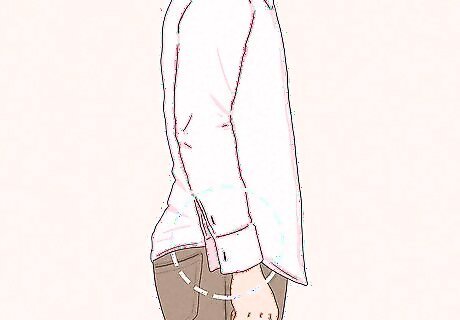
Unbutton the cuff and gauntlet buttons. Gauntlet buttons are the small buttons along the split in your sleeve above the cuff. If you have multiple gauntlet buttons, undo at least one—you can undo additional ones as you roll if the sleeve starts to feel restrictive. If you have thinner arms, consider keeping at least one gauntlet button done so the cuff hugs your arm a bit more closely.
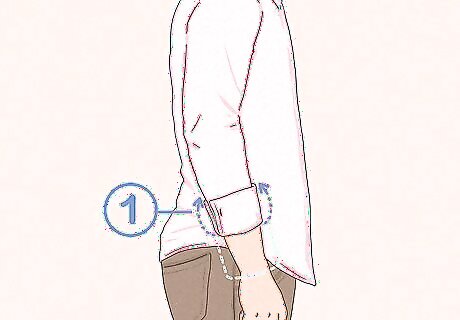
Fold the cuff at or just above the seam between the cuff and the sleeve. The cuff will determine the width of your rolls all the way up your forearm. Make sure you’re folding on the seam and not within the cuff itself—the roll will end up looking bulky, and the stuff cuff of your dress shirt will be permanently creased. Run a finger through the fold so that the inside-out cuff lays as flat as possible. Even though softer and less formal shirt cuffs can be folded outside the seam, it will look bulkier in the long run as you add more rolls.
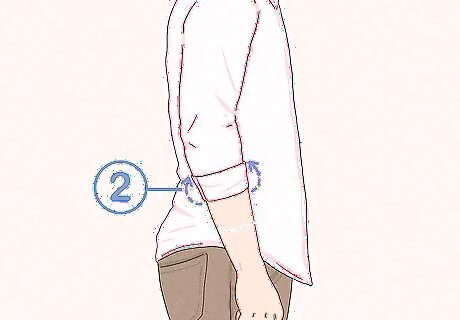
Fold your sleeve over the cuff so it’s inside-out. Straighten out your sleeve so the fabric isn’t baggy on the upper part of your arm, and run a finger through the fold to make sure the cuff is settled neatly inside. Feel how tight this double roll feels. If it’s restrictive, undo a gauntlet button to loosen it up. If you’re in a formal setting, consider stopping here (the classic roll). Continue rolling if you’re transitioning to a casual environment or need to keep your sleeves clean.
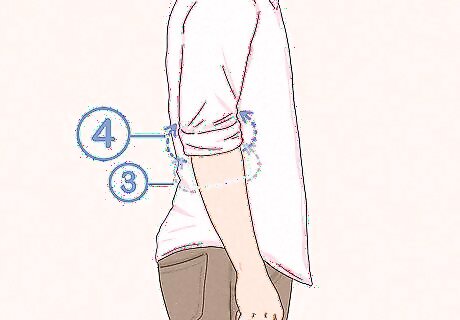
Fold over the cuff up to 2 more times for a below-the-elbow roll. Use the cuff as a guide to determine how wide to make each roll, making sure to smooth out and adjust the fabric after each one. Fold until the top of the roll is most of the way up your forearm, just below the elbow. Depending on the length of your sleeve, this may take 1-2 folds. Stop here if you don’t plan on doing any heavy physical activity. Make sure both rolls are equally tidy and the same length. If you’re wearing a tie, keep it on to maintain a professional look. If you’re at a function like a happy hour, consider loosening it slightly. Keep your cuff below the elbow to stay on the more formal side of things. As a general rule, the more arm you show, the more casual the look.
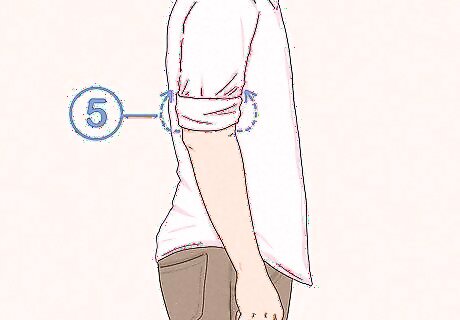
Fold the cuff once more for an above-the-elbow roll (the “High Roller”). Fold over the cuff again and push the roll up so the bottom edge of your sleeve is just above the elbow. Flatten out the folds for a clean look. This look is more casual and will definitely hug and show off your bicep for a “guns out” look. This look is best if you have to use your arms for intense physical activity and don’t want to stretch or wear out the elbows of your sleeves. The “High Roller” is more casual than either a basic below-the-elbow roll or the classic roll. If you have a tie on, consider loosening or even taking it off.
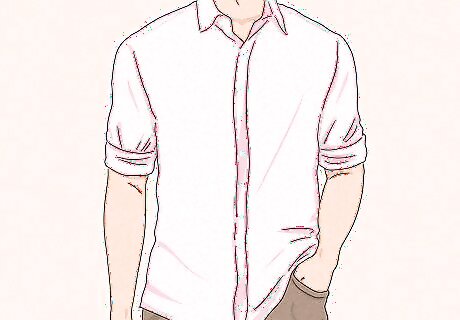
Repeat on your other sleeve. Tug and adjust both sleeves so the rolls lay as flat as possible and make sure they’re the same length. If the rolls are extra bulky, unroll your sleeves and start again—this time, make your very first fold slightly above the cuff seam so the roll is slightly wider, but flatter.
Master or Italian Roll (Any Occasion)

Undo all of the buttons on your cuff and sleeve. Check that all of your gauntlet buttons are undone, otherwise the end result will feel very tight and restrictive against your elbow. This fold works great on stiff, formal shirts but works on softer, more casual materials like flannel, too. Gauntlet buttons are the smaller buttons along the split in your sleeve above the cuff. Most button-downs and dress shirts have at least one per sleeve.
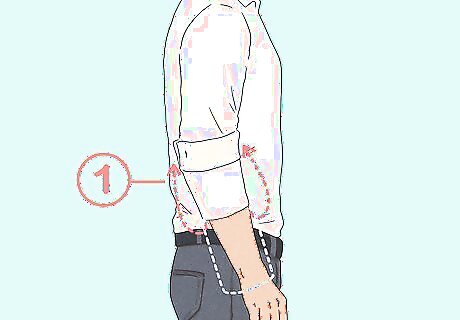
Flip the cuff inside-out and fold it up 1 inch (2.5 cm) past your elbow. Rather than folding at the cuff seam like other rolls, pull the cuff up your arm (turning your sleeve inside-out as you go) and stop when the bottom of the cuff is just above your elbow. You should still have the upper part of your forearm covered by the inside-out shirt sleeve. Depending on your preference, adjust the height of the cuff to sit just above or just below the elbow. Remember, a high roll is typically seen as more casual. This roll is very versatile since you can adjust the height to be whatever you like.
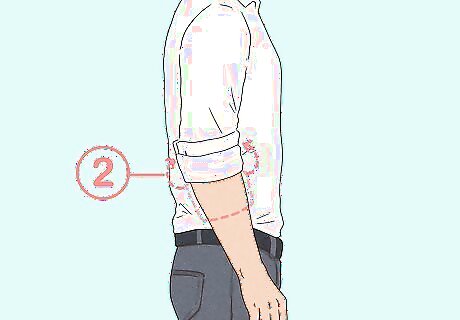
Flip the inside-out sleeve upward so the edge nearly covers the cuff. Aim to keep a thin sliver (up to about a third) of the cuff visible over the fold. Smooth out the edges of the fold so the roll lays flat and clean. If desired, adjust how much of the cuff is showing above the fold. If the inside of your cuff contrasts with the print or color of your shirt, let a full third of it show. It’s a very striking, stylish, attention-grabbing look.
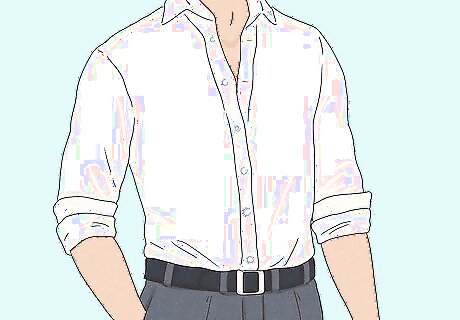
Repeat the fold on your other sleeve. Take a look at your first sleeve and decide whether you like the roll’s height (unfold and redo it higher or lower based on your preference). It might take a few tries to find the perfect height. Once that’s decided, fold the other sleeve to the exact same height. Make sure the same amount of cuff is exposed on both sleeves, too. Use this roll as a classy alternative to a classic or basic roll. It looks stylish and intentional in comparison, especially if the inside of the cuff has an interesting color or pattern. If you’re wearing a tie, keep it fastened if your roll is lower and more formal. Loosen it if the roll is higher and you’re in a more casual setting.
Sleeve Garter Cuff (Formal or Semi-Formal)
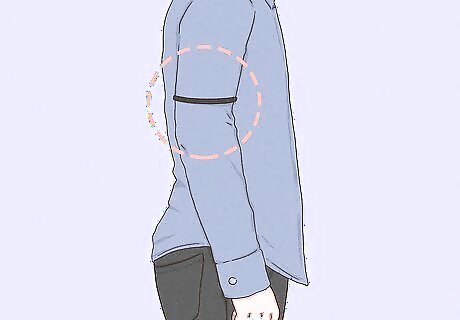
Pull the garter or band up and around the upper portion of your sleeve. Aim to secure it either a few inches above your elbow or around your mid-bicep. If your sleeves are extra long and you have a lot of fabric to get out of the way, place it slightly lower so you have room to push it up later. If you don’t have a garter, use a rubber band or hair tie in its place. Just make sure it’s not too tight and won’t cut off your circulation. Use garters with dress shirts, button-downs, or any shirt where you don’t want to stretch out or stress the cuffs.
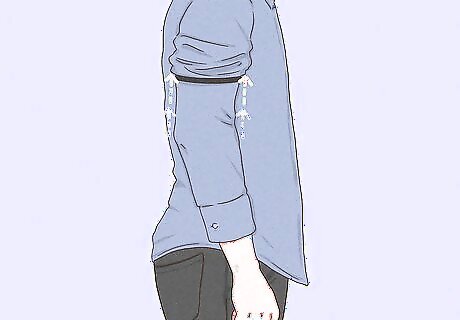
Pull the band and your shirt sleeve a few inches up your arm. There’s no folding or rolling required with a garter. The band holds the sleeve tight, so just nudge it upwards to pull your cuffs away from your wrists. Let the top portion of your sleeves billow out a little bit for an effortless look. Garters hold your rolls securely in place and won’t slide down or move around like a classic or basic roll might.
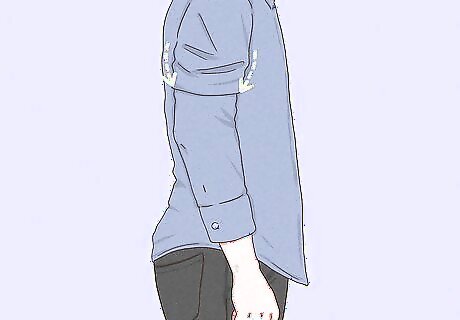
Fold excess fabric over the garter to make the upper sleeve less puffy. If you’ve got lots of billowy fabric up top or just want to cover up the band or garter, tug and fold the excess neatly over it. This creates a cleaner, more intentional look (especially if you’re using a rubber band in place of a garter). If you like the idea of a garter but don’t want it to show, try using it inside a classic, basic, or master roll to hold it in place.
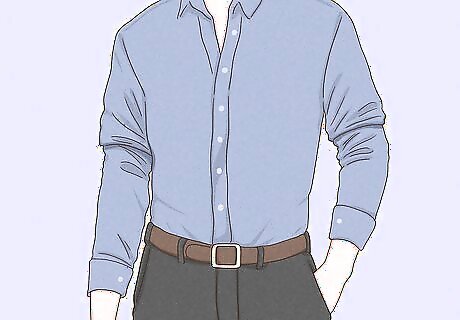
Keep your accessories simple if you’re wearing a sleeve garter. Sleeve garters are an old-school statement piece that draw a lot of attention, so wear them when you want to make a strong stylistic choice. Keep other bold accessories like bowties, fedoras, or suspenders to a minimum so you look well-dressed. All of these together can be distracting in an office or formal setting. The best accessory to pair with sleeve garters is confidence—they’ll definitely set you and your outfit apart from the crowd, so own it! Garters were popular in the early 20th century when dress shirts often didn’t have buttons on the cuffs and it was harder to find sleeves in various lengths.
Sweater Sleeves (Casual)
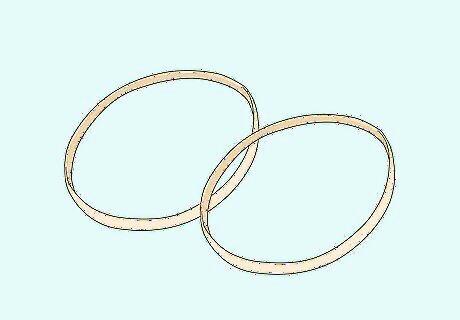
Grab two elastic bands, like hair ties or rubber bands. Make sure they’re big enough to fit comfortably around both your arm and the sweater sleeve. Hair ties are generally more comfortable than rubber bands, and thicker bands constrict your circulation less than thin ones. Elastic is a great way to hold saggy sweater sleeves in place. Since the fabric is looser than dress shirts, they’re likely to slip no matter how tight you roll them.
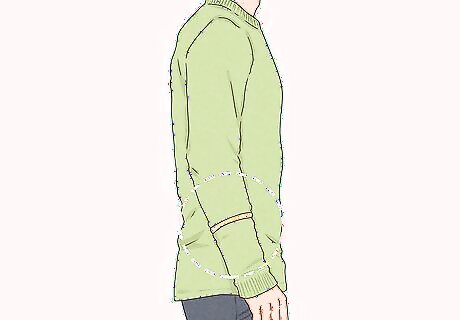
Place the elastic over your sleeve, about halfway up your forearm. Don’t worry if extra baggy sleeves bunch up around the band—you’ll be folding over that area and it won’t show. Look for a bigger or looser band if the one you chose feels too tight or uncomfortable.
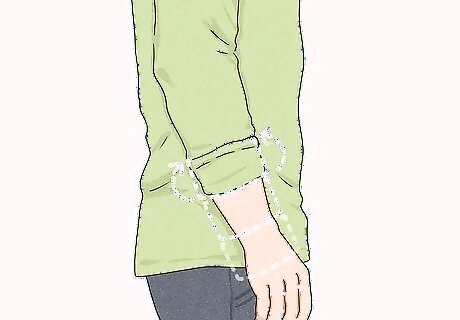
Roll your sleeve over the band and tuck it in on itself to make a “cuff.” For this first roll, make sure the fold line you make in your sleeve lines up with the rubber band. Look at the width of the fold—if it’s too big or bulky for your liking, move the rubber band closer to your wrist. If it seems thin, move it closer to your elbow.
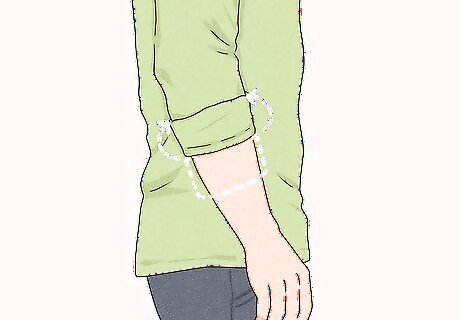
Keep rolling until the sleeve is at a comfortable height you like. There’s no specific number of rolls or folds here—just keep rolling and tucking until you like what you see. Adjust your final roll to make the “cuff” look tidy. If you like, slide the band up closer to your shoulder to make the upper part a little baggier. Keep the cuff below the elbow unless the sweater is very thin, otherwise the portion around your upper arm will look too bulky. The band will keep the sleeve in place all day long. No more worrying about baggy sleeves getting in the way! Rolled sweater sleeves usually look better and more casual when they’re below the elbow. Otherwise, your upper arm will look super bulky. Remember, rolled sweater sleeves will always be a casual look. Do this when you need to get your sleeves out of the way or to cool down.
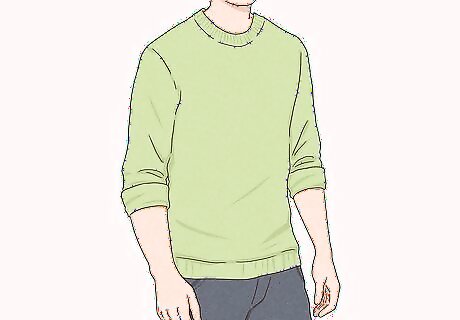
Repeat on your other sleeve. Place your second elastic band in the same spot on your other arm and aim to make a roll that’s equally thick and wide. Check your work in a mirror with your arms down at your side—make sure your sleeves are the same length and adjustment as needed.
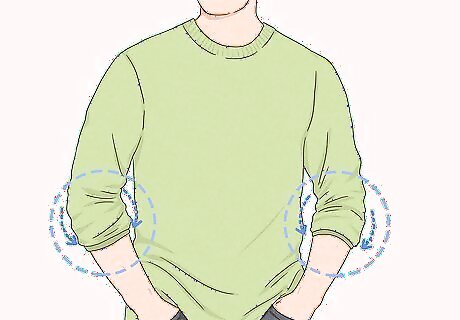
Get a cool “pushed up” look by folding your upper sleeve over the band. As an alternative, put your bands just a few inches above your wrist and then tug your sleeve toward your elbow (the band should be a few inches beneath it). Fold the extra fabric down over the band to hide it. Do this with oversized coats, sweaters, or even blazers. It’s a quick trick that gives you an effortless, cool look.
T-Shirt Sleeves (Casual)
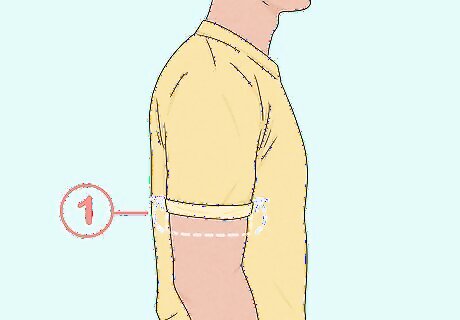
Fold your t-shirt sleeve along the stitched hemline. If your sleeve doesn’t have a visible hem, make a fold about 0.5 in (1.3 cm) or so wide instead. Make sure the fold is even all the way around your arm. If you’re having trouble folding the underarm portion while your shirt is on, try folding it while you’re getting dressed before putting it on.
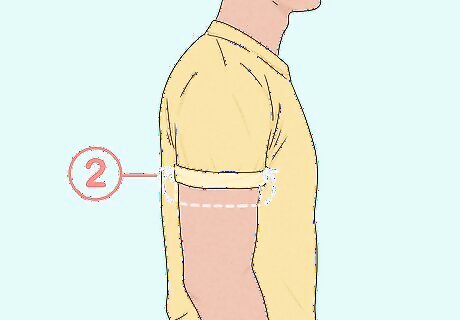
Keep folding or rolling your sleeve up until you reach the desired length. There’s no hard rule about how many rolls or how far up you should go—just stop when you like the way it looks. For a clean look, try to make folds that are the same width as the hem, and press them flat as you go. Sleeves that are rolled up close to the shoulder tend to look more like a statement rather than a casual roll.
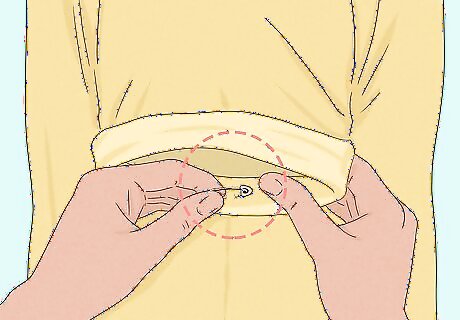
Pin the inside of your last fold with a safety pin for a crisp look. Use a small safety pin that won’t irritate you or protrude from the folds. Bend a small part of your last fold back out and slide the sharp end of the pin through the innermost layer, then close the pin. Pin near the underarm of the sleeve. It won’t be visible if the sleeve somehow comes unrolled (plus the underarm is the hardest area to keep flat). The safety pin helps keep a crisp, clean fold.
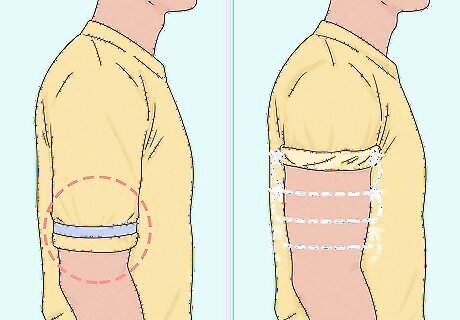
Use a rubber band in place of a pin for a messier, rugged look. While your sleeve is unrolled, place a large rubber band about 0.5 in (1.3 cm) above the bottom line of the sleeve. Roll your sleeve loosely over the rubber band as many times as you like, keeping the rubber band inside the rolls. Use a large rubber band or other elastic band that won’t cut off your circulation. Elastic bands last a long time and won’t slide up or down your arm.
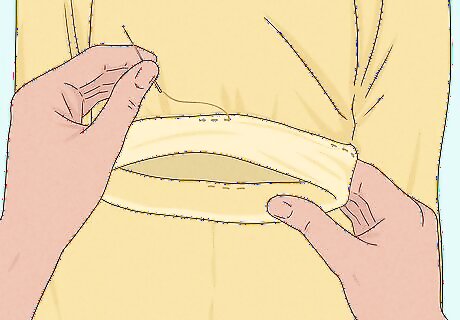
Stitch your folds closed for a permanent roll. While your shirt is off, use the hem as a guide to fold your t-shirt sleeve up as high as you like. Then, use a needle and thread to place single stitches along the top edge of the fold. Don’t worry if you’re not a master sewer—you only need to stitch 3 or 4 spots to secure the roll.
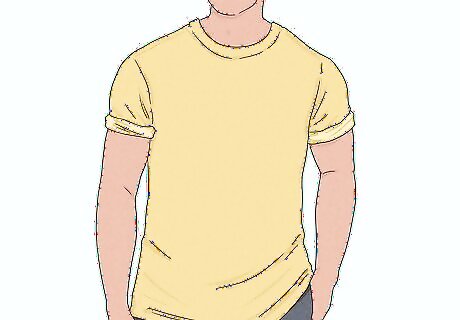
Repeat on the other sleeve. Roll your second sleeve the same number of times as the first one, using the hem as a guide so they’re the same width. Use whichever method you chose to secure the first sleeve—safety pins, rubber bands, or stitches—to secure the second one as well.




















Comments
0 comment